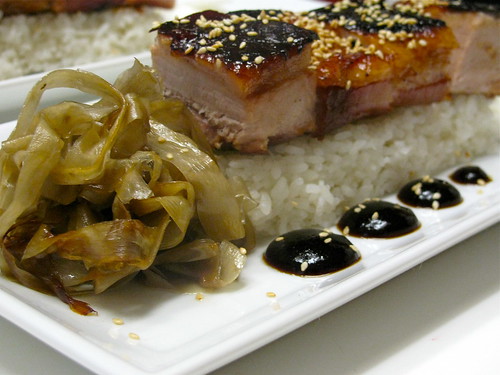I still had some soy pudding and lime sugar from the Alinea beef recipe I made recently and I hate to waste any (or at least waste much since that recipe made a lot of lime sugar) so for the pork belly I again thought about Asian flavors. This time it was more Japanese though. For the pork belly I marinated it in teriyaki sauce in a sealed FoodSaver bag and then cooked it sous vide for 12 hours at 170F. It was then cooled, and chilled with a weight on it to make sure it stays nice and flat. For service, I seared te pork, glazed it with Teriyaki sauce and sprinkled it with sesame seeds. This belly was skinless and I had a tough time getting a nice flat -seared cross hatch pattern on it. I am going to try leaving the skin on next time to see how that works out.
This was my first time using burdock root, a very common product in Japanese cooking. It’s like a long carrot with brown skin. I’ve read recipes where it is cooked and mashed, rolled in beef in yakitori and in salads. This particular recipe is from Shizuo Tsuji’s great book, “Japanese Cooking A Simple Art“. The burdock is peeled and shaved thin with a peeler. It is then sauteed in oil and seasoned with sake, soy and sugar. It looks like Linguine noodles with a slightly crunchy texture and a delicious nutty taste. This, along with the pork of course, was the highlight of the dish. I ate the leftover burdock “salad” cold the next day, very good as well.
The pork is served on a sushi rice block. I cooked it also following Tsuji’s instructions. It’s seasoned with a little sugar and rice wine vinegar. The bok choy was cooked in dashi (staple Japanese stock, made with giant kelp and bonito fish flakes) in which a little miso was mixed, basically miso soup. I wish I could say everything in this dish was perfect, but the bok choy was certainly wrong. It looked odd on the plate and tasted funky. Also the lime sugar was superfluous. The dish would’ve been perfect with only the rice, pork, burdock and soy pudding.



For searing pork belly at service, I always score it in a cross-hatch, but the key is putting something heavy and flat on top of it while it is in the pan cooking. I put the pork belly in a pan that’s over medium or even medium-low heat, put a cast iron pan on top of it, and let the top render and get crispy for 15 minutes or so. No need to touch it. Finally turn up the heat for the last minute or so, then quickly sear the other sides, let it rest on some paper towels, then trim up and slice it.
Well, it makes sense what went wrong with mine then. I did score it and weigh it with a cast iron skillet. However, I used too high a heat, more like medium high. That explains the lack of definition on the skin side.
So you’re just complaining that you couldn’t see the cross-hatch pattern? Or was it also not crispy?
Basically, my method is the same as you’d use for a duck breast. When you crosshatch it, you pretty much create little “cubes” of fat. If you render it slowly, those little cubes shrink as they lose the fat, causing them to separate and making the crosshatch more obvious. But for me, the crosshatch is a necessary evil, rather than something to strive for. I only do it because it helps it render and get crispier.
Well, both. Certainly they are related. I do like the aesthetic of the cross hatch pattern but also because of using much higher heat than you do and for a shorter time, I just got a dark sear, not much rendering of fat and a layer of fat that is not as crispy as it should.
I have another piece of belly in the freezer that was cooked at the same time in the water IC bath as this one (but seasoned differently). I will give that the slower, long sear and hopefully get what I want. Thanks for the hints.